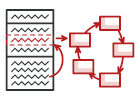
C#으로 작성된 상태
상태는 객체의 내부 상태가 변경될 때 해당 객체가 행동을 변경할 수 있도록 하는 행동 디자인 패턴입니다.
패턴은 상태 관련 행동들을 별도의 상태 클래스들로 추출하며 또 원래 객체가 자체적으로 작동하는 대신 위에 언급된 클래스들에 작업을 위임하도록 강제합니다.
복잡도:
인기도:
사용 사례들: 상태 패턴은 일반적으로 C#에서 대규모 switch 기반 상태 머신들을 객체들로 변환하는 데 사용됩니다.
식별: 객체들의 상태에 따라 행동을 변경하는 메서드들이 있으면 패턴은 상태 패턴으로 초기 식별될 수 있으며 이 상태가 상태 객체들 자체를 포함하여 다른 객체들에 의해 제어되거나 대체될 수 있으면 해당 패턴은 상태 패턴입니다.
개념적인 예시
이 예시는 상태 디자인 패턴의 구조를 보여주고 다음 질문에 중점을 둡니다:
- 패턴은 어떤 클래스들로 구성되어 있나요?
- 이 클래스들은 어떤 역할을 하나요?
- 패턴의 요소들은 어떻게 서로 연관되어 있나요?
Program.cs: 개념적인 예시
using System;
namespace RefactoringGuru.DesignPatterns.State.Conceptual
{
// The Context defines the interface of interest to clients. It also
// maintains a reference to an instance of a State subclass, which
// represents the current state of the Context.
class Context
{
// A reference to the current state of the Context.
private State _state = null;
public Context(State state)
{
this.TransitionTo(state);
}
// The Context allows changing the State object at runtime.
public void TransitionTo(State state)
{
Console.WriteLine($"Context: Transition to {state.GetType().Name}.");
this._state = state;
this._state.SetContext(this);
}
// The Context delegates part of its behavior to the current State
// object.
public void Request1()
{
this._state.Handle1();
}
public void Request2()
{
this._state.Handle2();
}
}
// The base State class declares methods that all Concrete State should
// implement and also provides a backreference to the Context object,
// associated with the State. This backreference can be used by States to
// transition the Context to another State.
abstract class State
{
protected Context _context;
public void SetContext(Context context)
{
this._context = context;
}
public abstract void Handle1();
public abstract void Handle2();
}
// Concrete States implement various behaviors, associated with a state of
// the Context.
class ConcreteStateA : State
{
public override void Handle1()
{
Console.WriteLine("ConcreteStateA handles request1.");
Console.WriteLine("ConcreteStateA wants to change the state of the context.");
this._context.TransitionTo(new ConcreteStateB());
}
public override void Handle2()
{
Console.WriteLine("ConcreteStateA handles request2.");
}
}
class ConcreteStateB : State
{
public override void Handle1()
{
Console.Write("ConcreteStateB handles request1.");
}
public override void Handle2()
{
Console.WriteLine("ConcreteStateB handles request2.");
Console.WriteLine("ConcreteStateB wants to change the state of the context.");
this._context.TransitionTo(new ConcreteStateA());
}
}
class Program
{
static void Main(string[] args)
{
// The client code.
var context = new Context(new ConcreteStateA());
context.Request1();
context.Request2();
}
}
}
Output.txt: 실행 결과
Context: Transition to ConcreteStateA.
ConcreteStateA handles request1.
ConcreteStateA wants to change the state of the context.
Context: Transition to ConcreteStateB.
ConcreteStateB handles request2.
ConcreteStateB wants to change the state of the context.
Context: Transition to ConcreteStateA.
 겨울 세일!
겨울 세일!
